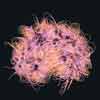Spam art
For the last several years, Romanian-born
computer artiste Alex Dragulescu has applied techniques in
computational modelling and information visualisation to invent
a new form of artistic expression. One of his more notable
projects involved creating what he calls Spam Plants. He wrote
algorithms that analysed various text and data points of junk
e-mail to produce ‘organic’ images of plant-like
structures that spontaneously grew based on incoming spam.
Now he's working on a software agent that
can ‘write’ experimental graphical novels, based
on a melange of texts culled from thousands of like-minded
blogs across the internet. When finished, the agent, called
Blogbot, will include algorithms that apply computational
linguistics to the blog text, so that it extracts meaning
from the text. That way, the graphical novel might strike
on profundity.
 “By
analysing text using computational linguistics methods, you
can detect anger and sadness. Turning those into gestures
in three dimensions would be interesting,” said Dragulescu,
who is now head of the Experimental Game Lab, a research lab
at the Centre for Research and Computing and the Arts (CRCA)
within the University of California at San Diego. “By
analysing text using computational linguistics methods, you
can detect anger and sadness. Turning those into gestures
in three dimensions would be interesting,” said Dragulescu,
who is now head of the Experimental Game Lab, a research lab
at the Centre for Research and Computing and the Arts (CRCA)
within the University of California at San Diego.
Dragulescu's work stands out at a time when
scientists and technologists are struggling to harness the
massive quantities of data online, and make sense of it for
fields like earth science, drug discovery, genetic research
and security. Information visualisation is a traditional scientific
method that's getting a lot of attention now, because it involves
projecting a visual image of the data, so that onlookers can
make connections that might otherwise be lost.
|